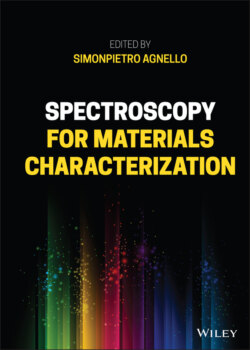Читать книгу Spectroscopy for Materials Characterization - Группа авторов - Страница 71
3.6.2 Relaxation of Excited Charge Carriers and Excitons in Semiconductor Nanoparticles
ОглавлениеUltrafast transient absorption experiments help to investigate, as already said, the sub‐picosecond and picosecond dynamics occurring in different materials after photoexcitation. As a further example, here we report some ultrafast TA studies conducted by Klimov's group ([27]) on CdSe nanocrystals aiming to investigate the fast carrier dynamics of electron–hole pairs and the effects produced by very intense pump excitation, capable of generating multiple excitations in the same nanocrystal.
The experiment consisted in the photoexcitation of CdSe colloidal NCs excited with 100 fs pulses peaking at 400 nm (3.1 eV, that is higher than CdSe bandgap) and in the consequent probing of the absorption changes in the visible‐IR range. The size of the studied nanocrystals is small enough to fall in the strong confinement regime (diameter smaller than Bohr radius), characterized by an energy spacing between the lowest electron states larger than both the exciton binding energy and the longitudinal optical phonon. The results obtained by TA provided a comprehensive picture of the dynamics of photoexcited charge carriers from the very first moment after photoexcitation.
Figure 3.8a reports typical TA spectra observed in the system at different delays from photoexcitation. The features appearing in the TA spectra can be given a definite identity by a direct comparison with features present in the steady state spectrum. For example, the lowest‐energy feature B1 clearly visible in both the TA and steady state spectra is associated to e–h pairs formed by an electron in the 1S state and a hole in the 1S3/2 state. The spectra at relatively long times (ps) are mostly explained by the bleach of several features of the absorption spectrum, due to the reduced absorption after one (at low pump intensities) or more e–h couples have been generated by photoexcitation. These bleaching signals, also named state filling effects, appear as positive signals in Figure 3.8a because the TA is reported with inverted sign (−Δα). Besides state filling effects, a peculiar derivative‐like shape, composed by features B1 and A1, shows up in the TA at short times. This feature is attributed to bi‐exciton interactions, that are the Coulombic interactions between the e–h pairs generated by the pump and the probe. On increasing pump–probe time delay, carriers relax from initially high excited to low‐energy states, the coulombic contributions diminish and the state filling contributions dominate the spectra. Therefore, the spectral evolution in Figure 3.8a provides direct information on the timescales of the carrier energy cascade in semiconductor NCs.
Beyond the timescales of carrier dynamics, TA signals collected at different pump powers (Figure 3.8b) provide some useful additional information. When the pumping intensity is low enough, the photoexcited average NC population can be estimated to be lower than 1, that is less than one e–h pair generated on average per NC. However, if the power is increased in order to have average NC population greater than 1, new decay components show up in the temporal kinetics of the TA signals, as clearly visible in Figure 3.8b. These components are due to the activation of new non‐radiative depopulation channels in the sub‐nanosecond regime, due to the Auger recombination events which become possible whenever multiple e–h pairs coexist in the same quantum dot. Interestingly, the Auger lifetimes turn out to be quantized, because the number of generated e–h pairs can only be discrete, yielding a progression of decay lifetimes which depend on pump power (Figure 3.8b). Therefore, the carrier dynamics result to be faster if the power and, consequently, the number of e–h pairs per NC increase.
Figure 3.8 (a) TA spectra of CdSe NCs recorded at 0.1, 0.5, and 2 ps compared with the steady state absorption. The features Ai are associated to bi‐exciton Coulombic interactions decaying in time, while features Bi are due to depopulation of the ground state. (b) TA kinetics of the 1‐, 2‐, 3‐, and 4‐ e–h couples fit to a single‐exponential decay.
Source: Adapted with permission from Klimov [27]. Copyright (2000) American Chemical Society.
